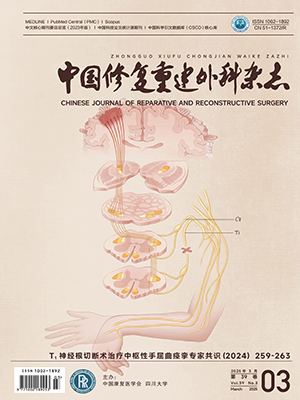Objective To evaluate the safety and efficacy of the operation performed under the video-assisted thoracoscope to release the anterior part of the spine of the patient with severe adolescent idiopathic scoliosis (AIS). Methods From April 2004 to July 2006, 24 patients with AIS (Illness course, 1.5-9 years; Lenke Ⅰ in 17 patients, Lenke Ⅱ in 7; right scoliosis in 22, left scoliosis in 2), among whom there were 9 males and 15 females, with an average age of 14.7 years (range, 11-21 years) at the time of the operation. Before operation, the thoracic vertebral Cobb anger at the coronal plane was averaged 78.3°(range, 65-125°). All the patients had normal muscle strength and muscle tension in their lower limbs, but 5 of the patients had a decrease of the superficial sensation in their lower limbs. All the patients had a moderately or severely decreased lung reserve function. Under general anesthesia, the patient was placed in the lateral position to set up a work channel for thoracoscopy. The releasing of the thoracic intervertebral space and the confluence of the bone grafts were performed. During Stage Ⅰ or Stage Ⅱ, the orthopedic procedures for the posterior part of the scoliosis spine, the internal fixation, and the confluence ofthe bone grafts were completed. ResultsAll the patients survived the periodof perioperation. During operation, there was a hemorrhage of 50-200 ml, averaged 100 ml, with a postoperative thoracic closely-drained fluid of 100-150 ml. The incision was healed by the first intention. Each patient underwent the releaseof 4-6 intervertebral spaces, with an average of 5.5 spaces released. The average coronal Cobb angle was 45.6°(range, 25-75°). The physiological curvatureat the sagittal plane was normal, with an improved shape of the spine. The follow-up for 3-18 months averaged 9.3 months revealed that the bilateral pulmonary markings were clear, with confluence of the orthopedic segment of the spine. The patients could live and work normally, and had a significantly-improved psychological condition and an active social participation because of their improved appearance. Conclusion The releasing of the anterior part of the spine under the video-assisted thoracoscope can effectively release the adolescent idiopathic scoliosis and improve the flexibility of the spine, with a smaller degree of the surgical wound and a faster and clearer exposure of the spinal column during operation.
Citation: LIU Limin,SONG Yueming,LI Tao.. RELEASING ANTERIOR PART OF SPINE UNDER VIDEO-ASSISTED THORACOSCOPE FOR TREATMENT OF ADOLESCENT IDIOPATHIC SCOLIOSIS. Chinese Journal of Reparative and Reconstructive Surgery, 2007, 21(8): 825-828. doi: Copy
Copyright © the editorial department of Chinese Journal of Reparative and Reconstructive Surgery of West China Medical Publisher. All rights reserved




